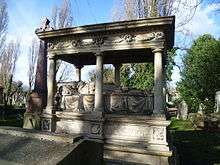James Pulham and Son


James Pulham and Son was a firm of Victorian landscape gardeners and terracotta manufacturers which exhibited and won medals at London's Great Exhibition of 1851 and 1862 International Exhibition.[1]
History
James Pulham and Son was founded by James Pulham (1793–1838) of Woodbridge in Suffolk, who was succeeded by his eldest son James (1820–1898) and then by two more generations of eldest sons, both also named James. The firm went out of business in 1939.[2]
The firm was best known for the construction of rock gardens, follies and grottoes in which the firm used both natural stone and their own invention, Pulhamite artificial rock. Pulham and Son also manufactured a wide range of terracotta and Pulhamite garden ornaments, originally at their works in Tottenham, but after 1840 at Broxbourne in Hertfordshire. In 1895 the firm was granted a Royal Warrant by the Prince of Wales, later King Edward VII and some of their work survives at Sandringham House and Buckingham Palace.[1]
After exhibiting at the Great Exhibition of 1862. One of the two works exhibited there was the upper section of what is now Dunorlan Fountain (from Dunorlan Park, Tunbridge Wells). Originally called the 'Hebe Fountain' (due to the image of Hebe - daughter of Zeus, at the top). James Pullham II (the son) received a recommendation for the architectural decoration in terracotta.[3]
At the 1867 Paris Exhibition the company showed the "Preston vase" (several of which were made for the People's Park, Preston), and the Mulready monument.[4] The latter, modelled by Godfrey Sykes[1] consisted of a pedestal 15 feet long and 10 feet wide, supporting an effigy, seven feet long, on a raised bier. It won a silver medal at the exhibition, and was installed at Kensal Green cemetery on its return from Paris.[4]
References
- 1 2 3 http://www.parksandgardens.ac.uk/index2.php?option=com_content&task=view&id=336&pop=1&page=5&Itemid=1
- ↑ Hitching, Claude. "Pulham Legacy". www.pulham.org. Retrieved 2015-12-13.
- ↑ Pulham.org article on the fountain
- 1 2 Jewitt, Llewellyn (1878). The Ceramic Art of Great Britain. 1. London: Virtue & Co. pp. 428–31. Retrieved 21 October 2011.
External links
- The Pulham Legacy
- Durability Guaranteed - Pulhamite Rockwork pdf file on the English Heritage website.
| Wikimedia Commons has media related to James Pulham and Son. |